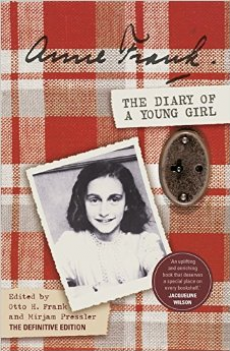
If you learned anything about the Holocaust or the Second World War at school, then you’ve probably heard of Anne Frank. She was an ordinary teenager living in Amsterdam, but she was also Jewish, and was thus caught up in the horrendous events of the 1930s and 1940s. The diary itself was given to Anne as a birthday present, before she and her family went into hiding in their “secret annexe” behind a bookcase in their father’s business. She had picked it herself, and thus was born the world’s most famous diary. But this one little book wasn’t enough to contain all of Anne’s thoughts, and before their arrest in 1944, Anne had used two more books.
So that’s a bit of backstory about why Anne started to write, but what was it she wrote about? Well, if you read the published version, there’s about 300 pages. She begins by introducing herself, her family, and her friends at school (the Jewish Lyceum). It sounds like she didn’t feel particularly close to many of her friends, even though there were lots of people she called friends. Overall, this looks like a happy time in her life, before all the trouble began. Once Anne and family go into hiding, Anne writes mostly about her innermost thoughts and feelings. These are a great insight into Anne’s personality, or at least how she saw herself, and how she thought others saw her. She also writes about everyday goings on in their secret hideout, like the quarrels between them, and even how the preserved food is kept. There are also some perceptive comments about how the war is going, how she wants the future to be, and even problems with society and inequality.
Anne nicknames her diary “Kitty”, and writes it like she’s writing a letter to her friend. This makes her format all the more interesting! Her style changes throughout the diary. As she gets older, her writing becomes much more fluid, whereas at the beginning it’s quite simple and over dramatic. She begins to mature, but her comments about certain people in their hideout reflect her change of opinion about them. This also gives us an insight into how Anne mentally grew up.
If you read the published version, though, it’s been edited by both Anne herself and her father. A broadcast on the radio from the Dutch Government in exile asked people to keep diaries of their experiences during the war, so that when they were finally free, their diaries could be used as a record for people in the future to learn about everyday life under occupation. Once Anne heard this, she seriously began to think about publishing her diary, so started to make changes to the text. After Anne’s father was given the diary, he also edited parts out, in order to make Anne’s dream of becoming a famous writer finally come true. It’s not a difficult book to read, because it’s written by a teenager. It might be long, but it’s one of those books you can’t not read – it’s moving and touching. But most of all, it’s important, and rightly takes its place on the Memory of the World Register.
Image credit: http://www.amazon.co.uk/The-Diary-Young-Girl-Definitive/dp/0141315180

0 Comment:
Be the first one to comment on this article.